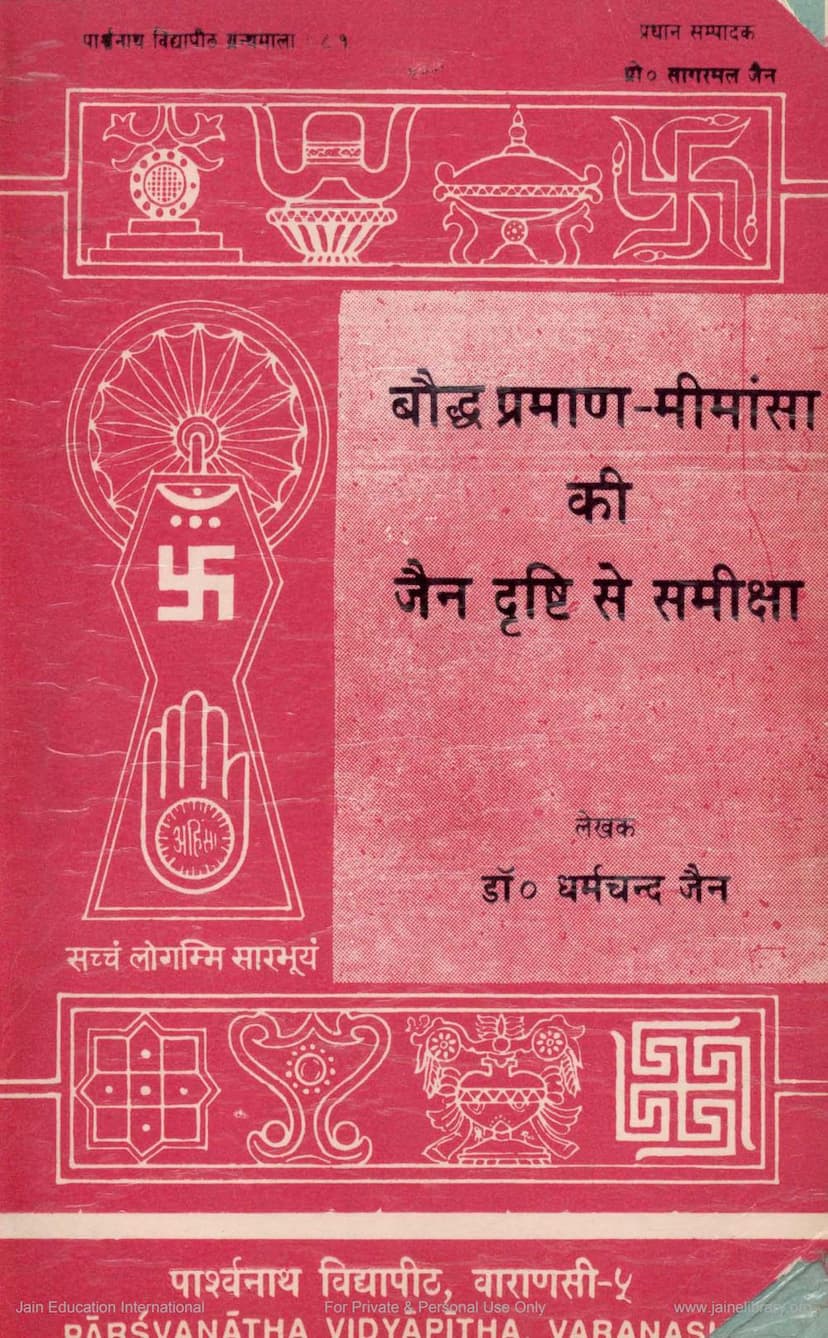Bauddh Pramana Mimansa Ki Jain Drushti Se Samiksha
Added to library: September 1, 2025

Summary
This Jain text, "Bauddh Pramana Mimansa Ki Jain Drushti Se Samiksha" (A Review of Buddhist Theory of Knowledge from a Jain Perspective) by Dr. Dharmchand Jain, published by Parshwanath Shodhpith Varanasi in 1995, offers a comprehensive comparative analysis of the epistemological systems of Jainism and Buddhism. The book aims to present the criticisms leveled by Jain philosophers against Buddhist theories of knowledge.
Key Themes and Structure:
The book is structured into six chapters, systematically examining various aspects of the epistemological debate between Jainism and Buddhism:
-
Chapter 1: Tradition of Pramana Mimansa in Buddhism and Jainism: This foundational chapter introduces the historical context of epistemological discourse in both Shramana traditions. It highlights the significant differences in their metaphysical and epistemological views, with Buddhism's focus on momentariness and idealism contrasting with Jainism's emphasis on permanence-impermanence (nityānitaya) and external reality. The chapter traces the systematic development of Buddhist epistemology from Dignāga (5th century CE) onwards, followed by the rise of Jain epistemology starting with Siddhasena (5th-6th century CE) and further developed by Akalanka and subsequent Jain logicians. It acknowledges the influence of Buddhist logic on Jainism while emphasizing the unique contributions of Jain thinkers.
-
Chapter 2: Pramana-Lakshana and Pramanavaada (Theory of Knowledge): This chapter delves into the definitions and theories of "Pramana" (means of valid knowledge) in both traditions. It analyzes the Buddhist conceptualizations of Pramana as knowledge that generates valid awareness of unknown reality, as non-discrepant knowledge, and as knowledge that conforms to the object's form. The Jain perspective, while generally agreeing on Pramana being cognitive in nature, criticizes the Buddhist emphasis on knowledge being only of the unknown, the non-conceptual nature of perception, and the denial of certain other valid means of knowledge accepted by Jainism.
-
Chapter 3: The Pramana of Perception (Pratyaksha): This chapter focuses on the Buddhist theory of perception, particularly the debate around "kalpanapodha" (free from conceptualization) and "abhraanta" (non-erroneous). It discusses Dignāga's foundational views, Dharmakirti's refinement with the addition of "abhraanta," and the subsequent elaborations by Dharmottara, Shantarashita, and Kamalashila. The Jain critique here is significant, as they argue that all perception is conceptual (savikalpaka) and that the Buddhist concept of nirvikalpaka perception is untenable and fails to explain practical application. The chapter also examines the Buddhist categories of perceptual knowledge like mental perception and self-cognition, contrasting them with Jain classifications of direct (pratyaksha) and indirect (paroksha) knowledge, including divine knowledge (avadhi, manahparyaya, kevala) which they consider transcendental direct perception.
-
Chapter 4: The Pramana of Inference (Anumana): This chapter critically analyzes the Buddhist theory of inference, particularly the "trirupya" (three characteristics) of the middle term (hetu) – presence in the subject (pakshadharma), presence in the locus similar to the subject (sapakasattva), and absence in the dissimilar locus (vipaksha-vyavritti). The Jain critique centers on the necessity of all three characteristics, arguing that "anyathānupapatti" (inconceivability otherwise) or "avyabhivachita" (non-falsifiable) relationship between the middle term and the predicate is sufficient for valid inference. The chapter also examines Buddhist classifications of hetu (svabhava, karya, anupalabdhi) and their critique by Jain logicians who introduce categories like purvachara, uttarachara, and saharachara hetus.
-
Chapter 5: The Pramana of Memory (Smriti), Recognition (Pratyabhijna), Logic (Tarka), and Testimony (Agama), and the Theory of Apoha: This chapter explores the Jain acceptance of Smriti, Pratyabhijna, and Tarka as distinct valid means of knowledge, a position vehemently rejected by Buddhists. Buddhists, particularly Dignāga and Dharmakirti, considered Smriti and Pratyabhijna as deriving their validity from valid perception and inference, and Tarka (logic) as merely an aspect of inference. The chapter also examines the Buddhist theory of "Apoha" (negation or exclusion) as the meaning of language and its critique by Jain logicians, who uphold a theory of conventional meaning and direct relation between words and things.
-
Chapter 6: Pramaya (Object of Knowledge), Pramana-phala (Result of Pramana), and Pramanabhāsa (Fallacies of Pramana): This concluding chapter discusses the differing views on the nature of reality (prameya) and the result of knowledge (pramana-phala). It highlights the Buddhist distinction between "svalakshana" (particulars) as ultimate reality and "samanya-lakshana" (generals) as conventional reality, with perception apprehending the former and inference the latter. Jainism, in contrast, posits a single reality that is both general and particular (sāmānya-viśeṣātmaka) and is accessible through various means of knowledge. The chapter also touches upon the Buddhist concept of "pramana-phala" and its critique by Jain scholars, particularly regarding the "arthasārūpya" (similarity of form) between knowledge and object, which Jain logicians argue against.
Overall Contribution:
The book is significant for several reasons:
- Scholarly Rigor: It is based on a doctoral dissertation, indicating a thorough study of original Sanskrit texts from both Buddhist and Jain philosophical traditions.
- Comparative Analysis: It provides a detailed and nuanced comparison of the epistemological frameworks of two major Indian philosophical schools, highlighting their points of agreement and, more importantly, their fundamental disagreements.
- Rehabilitation of Jain Logic: By presenting the sophisticated logical arguments and critical analyses of Jain scholars against Buddhist epistemology, the book contributes to a deeper understanding and appreciation of the strength and originality of Jain logic.
- Historical Context: It situates the epistemological debates within their historical development, tracing the evolution of ideas from early Buddhist texts to later developments in both traditions.
- Accessible Scholarship: Despite the complex nature of the subject matter (epistemology and logic), the author and publishers have aimed to make this profound topic accessible to a wider audience, especially in Hindi.
In essence, "Bauddh Pramana Mimansa Ki Jain Drushti Se Samiksha" is a vital scholarly work that illuminates the intellectual engagement between Jainism and Buddhism on the fundamental questions of knowledge and reality, showcasing the critical acumen and philosophical depth of Jain thinkers in their engagement with Buddhist thought.